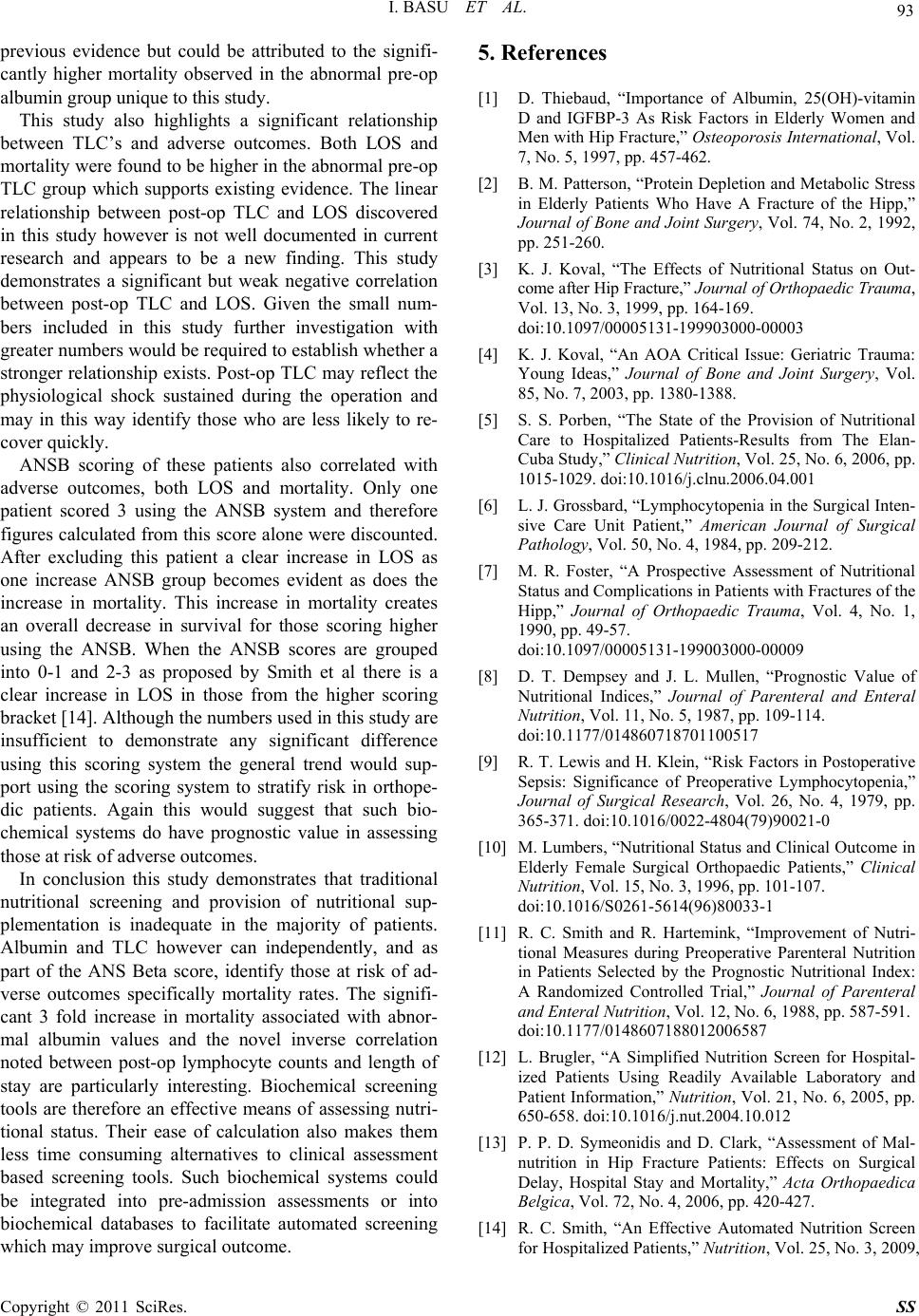
I. BASU ET AL.
93
previous evidence but could be attributed to the signifi-
cantly higher mortality observed in the abnormal pre-op
albumin group unique to this study.
This study also highlights a significant relationship
between TLC’s and adverse outcomes. Both LOS and
mortality were found to be higher in the abnormal pre-op
TLC group which supports existing evidence. The linear
relationship between post-op TLC and LOS discovered
in this study however is not well documented in current
research and appears to be a new finding. This study
demonstrates a significant but weak negative correlation
between post-op TLC and LOS. Given the small num-
bers included in this study further investigation with
greater numbers would be required to establish whether a
stronger relationship exists. Post-o p TLC may reflect the
physiological shock sustained during the operation and
may in this way identify those who are less likely to re-
cover quickl y .
ANSB scoring of these patients also correlated with
adverse outcomes, both LOS and mortality. Only one
patient scored 3 using the ANSB system and therefore
figures calculated from this score alone were discounted.
After excluding this patient a clear increase in LOS as
one increase ANSB group becomes evident as does the
increase in mortality. This increase in mortality creates
an overall decrease in survival for those scoring higher
using the ANSB. When the ANSB scores are grouped
into 0-1 and 2-3 as proposed by Smith et al there is a
clear increase in LOS in those from the higher scoring
bracket [14]. Although the numbers used in this study are
insufficient to demonstrate any significant difference
using this scoring system the general trend would sup-
port using the scoring system to stratify risk in orthope-
dic patients. Again this would suggest that such bio-
chemical systems do have prognostic value in assessing
those at risk of adverse outcomes.
In conclusion this study demonstrates that traditional
nutritional screening and provision of nutritional sup-
plementation is inadequate in the majority of patients.
Albumin and TLC however can independently, and as
part of the ANS Beta score, identify those at risk of ad-
verse outcomes specifically mortality rates. The signifi-
cant 3 fold increase in mortality associated with abnor-
mal albumin values and the novel inverse correlation
noted between post-op lymphocyte counts and length of
stay are particularly interesting. Biochemical screening
tools are therefore an effective means of assessing nutri-
tional status. Their ease of calculation also makes them
less time consuming alternatives to clinical assessment
based screening tools. Such biochemical systems could
be integrated into pre-admission assessments or into
biochemical databases to facilitate automated screening
which may improve surgical outcome.
5. References
[1] D. Thiebaud, “Importance of Albumin, 25(OH)-vitamin
D and IGFBP-3 As Risk Factors in Elderly Women and
Men with Hip Fracture,” Osteoporosis International, Vol.
7, No. 5, 1997, pp. 457-462.
[2] B. M. Patterson, “Protein Depletion and Metabolic Stress
in Elderly Patients Who Have A Fracture of the Hipp,”
Journal of Bone and Joint Surgery, Vol. 74, No. 2, 1992,
pp. 251-260.
[3] K. J. Koval, “The Effects of Nutritional Status on Out-
come after Hip Fracture,” Journal of Orthopaedic Trauma,
Vol. 13, No. 3, 1999, pp. 164-169.
doi:10.1097/00005131-199903000-00003
[4] K. J. Koval, “An AOA Critical Issue: Geriatric Trauma:
Young Ideas,” Journal of Bone and Joint Surgery, Vol.
85, No. 7, 2003, pp. 1380-1388.
[5] S. S. Porben, “The State of the Provision of Nutritional
Care to Hospitalized Patients-Results from The Elan-
Cuba Study,” Clinical Nutrition, Vol. 25, No. 6, 2006, pp.
1015-1029. doi:10.1016/j.clnu.2006.04.001
[6] L. J. Grossbard, “Lymphocytopenia in the Surgical Inten-
sive Care Unit Patient,” American Journal of Surgical
Pathology, Vol. 50, No. 4, 1984, pp. 209-212.
[7] M. R. Foster, “A Prospective Assessment of Nutritional
Status and Complications in Patients with Fractures of the
Hipp,” Journal of Orthopaedic Trauma, Vol. 4, No. 1,
1990, pp. 49-57.
doi:10.1097/00005131-199003000-00009
[8] D. T. Dempsey and J. L. Mullen, “Prognostic Value of
Nutritional Indices,” Journal of Parenteral and Enteral
Nutrition, Vol. 11, No. 5, 1987, pp. 109-114.
doi:10.1177/014860718701100517
[9] R. T. Lewis and H. Klein, “Risk Factors in Postoperative
Sepsis: Significance of Preoperative Lymphocytopenia,”
Journal of Surgical Research, Vol. 26, No. 4, 1979, pp.
365-371. doi:10.1016/0022-4804(79)90021-0
[10] M. Lumbers, “Nutritional Status and Clinical Outcome in
Elderly Female Surgical Orthopaedic Patients,” Clinical
Nutrition, Vol. 15, No. 3, 1996, pp. 101-107.
doi:10.1016/S0261-5614(96)80033-1
[11] R. C. Smith and R. Hartemink, “Improvement of Nutri-
tional Measures during Preoperative Parenteral Nutrition
in Patients Selected by the Prognostic Nutritional Index:
A Randomized Controlled Trial,” Journal of Parenteral
and Enteral Nutrition, Vol. 12, No. 6, 1988, pp. 587-591.
doi:10.1177/0148607188012006587
[12] L. Brugler, “A Simplified Nutrition Screen for Hospital-
ized Patients Using Readily Available Laboratory and
Patient Information,” Nutrition, Vol. 21, No. 6, 2005, pp.
650-658. doi:10.1016/j.nut.2004.10.012
[13] P. P. D. Symeonidis and D. Clark, “Assessment of Mal-
nutrition in Hip Fracture Patients: Effects on Surgical
Delay, Hospital Stay and Mortality,” Acta Orthopaedica
Belgica, Vol. 72, No. 4, 2006, pp. 420-427.
[14] R. C. Smith, “An Effective Automated Nutrition Screen
for Hospitalized Patients,” Nutrition, Vol. 25, No. 3, 2009,
Copyright © 2011 SciRes. SS